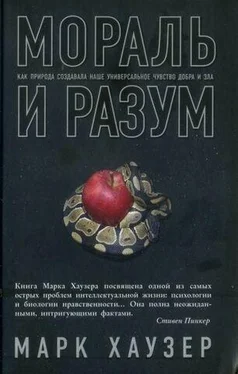Smuts В. B. (1987). Gender, aggession, and influence // В. B. Smuts & T. S. Struhsaker & R. Seyfarth & D. Cheney & R. W Wrangham (Eds.), Primate Societies (p. 400—412). Chicago: University of Chicago Press.
Sober E. (1994). From a Biological Point of View. Cambridge: Cambridge University Press.
Sober E. & Wilson D. S. (1998). Unto Others. Cambridge, MA: Harvard University Press.
Sodian B., Taylor C, Harris P L. & Pemer J. (1991). Early deception and the child’s theory of mind: false trains and genuine markers // Child Development, 62, 468—483.
Solomon R. C. (2002). Back to basics: on the very idea of “basic emotions” // Journal for the Theory of Social Behavior, 32, 115—144.
Sorensen R. (1991). Thought experiments // American Scientist, May—June, 250— 263.
Spelke E. (2000). Core knowledge // American Psychologist, 55, 1233—1243.
Spelke E. S. (1994). Initial knowledge: six suggestions // Cognition, 50, 431—445.
Sperber D. & Girotto V. (in press). Does the selection task detect cheater-detection? //J. Fitness & K. Sterelny (Eds.), New Directions in Evolutionary Psychology. Abingdon, UK: Taylor & Francis.
Spikka M., Newberry R. C. & BekoffM. (2001). Mammalian pay: training for the unexpected // Quarterly Review of Biology, 76, 141—168.
Sprengelmeyer R., Young A. W., Calder A. J., Kamat A., Lange H., Homberg V, Perrett D. I. & Rowland D. (1996). Loss of disgust: perception of faces and emotions in Huntington’s disease // Brain, 119 , 1647—1665.
Sprengelmeyer R., Young A. W., Pundt /., Sprengelmeyer A., Calder A. J., Berrios G., Wingkel R., Vollmoeller W., Kuhn W., Sartory G. & Przuntek H. (1997). Disgust implicated in obsessive-compulsive disorder // Proceedings of the Royal Society of London, В, B264, 1767—1773.
Stammbach E. (1988). Group responses to specially skilled individuals in a Macaca fascicularis // Behaviour, 107, 241—266.
Stamps J. A. & Krishnan V. V. (1999). A learning-based model of territory establishment // Quarterly Review of Biology, 74, 291—318.
Stephens D. W., McLinn С. M. & Stevens J. R. (2002). Discounting and reciprocity in an iterated prisoner’s dilemma // Science, 298, 2216—2218.
Stevens D., Chairman T & Blair R. J. R. (2001). Recognition of emotion in facial expressions and vocal tones in children with psychopathic tendencies // Journal of Genetic Psychology, 162, 201—211.
Stevens J. R. (2004). The selfish nature of generosity: harassment and food sharing in primates // Proceedings of the Royal Society, London, B, 271, 451—456.
Stevens J. R., Cushman F A. & Hauser M. D. (2005). Evolving the psychological mechanisms for cooperation // Annual Review of Ecology and Systematics, 36, 499—518.
Stevens J. R., Hallinan E. V. & Hauser M. D. (2005). The ecology and evolution of patience in two New World primates // Biology Letters, 1, 223—226.
Stevenson-Hinde J., Stillwel-Barnes R. & Zunz M. (1980). Subjective assessment of rhesus monkeys over four sucessive years // Primates, 21, 223—233.
Stingl M. & Colier J. (2005). Reasonable partiality from a biological point of view // Ethical Theory and Moral Practice, 8, 11—24.
Stone V. E., Cosmides L., Toohy J., Kroll N. & Knight R. T. (2002). Selective impairment of reasoning about social exchange in a patient with bilateral limbic system damage // Proceedings of the National Academy of Sciences, USA, 99, 11531— 11536.
Sunstein C. R., Hastie R., Payne J. W., Schkade D. A. & Viscusi W. К (2002). Punitive Damages. How Juries Decide. Chicago: University of Chicago Press.
Sweetser E. (1987). The definition of “lie”: an examination of the folk models underlying a semantic prototype // D. Hollard & N. Quinn (Eds.), Cultural Models in Language and Thought. New York: Cambridge University Press.
Talwar V & Lee K. (2002). Development of lying to conceal a transgression: children’s control of expressive behaviour during verbal deception // International Journal of Behavioral Development, 26, 436—444.
Talwar V, Lee K, Bala N. & Lindsay R. C. L. (2002). Children’s conceptual knowledge of lying and its relation to their actual behaviors: implications for court competence examinations // Law and Human Behavior, 26, 395—415.
Tarr M. J. & Gauthier I. (2000). FFA: A flexible fusiform area for subordinate-level visual processing automatized by expertise 11 Nature Neuroscience, 3, 7 64—769.
Tetlock P. E. (2003). Thinking the unthinkable: sacred values and taboo cognitions // Trends in Cognitive Science, 7, 320—324.
Tetlock P. E., Kristel О. V, Elson S. B. & Lemer J. S. (2000). The psychology of the unthinkable: taboo trade-offs, forbidden base rates, and heretical counterfactuals // Journal of Personality and Social Psychology, 78, 853—870.
Thompson С, Barresi J. & Moore С. (1997). The development of future-oriented prudence and altruism in preschoolers // Cognitive Development, /2, 199—212.
Thomson J.J. (1970). Individuating actions //Journal of Philosophy, 68 , 774—781.
Thomson J. J. (1971). A defense of abortion // Philosophy and Public Affairs, /, 47—66.
Tinkelpaugh O. L. (1928). An experimental study of representative factors in monkeys //Journal of Comparative Psychology, 8> 197—236.
Tinkelpaugh O. L. (1932). Multiple delayed reaction with chimpanzees and monkeys // Journal of Comparative Physiological Psychology, 13 , 207—224.
Tobin //., Longue A. W ., Chelonis J. J. & Ackerman К. T (1996). Self-control in the monkey Macaca fascicularis // Animal Learning and Behavior, 24, 168—174.
Todd P. M. & Gigerenzer G. (2003). Bounding rationality to the world // Journal of Economic Psychology, 24, 143—165.
Tomasello M. & G*// /. (1997). Primate Cognition. Oxford: Oxford University Press.
Tomasello M. y Call J. & Hare B. (2003). Chimpanzees understand psychological states — the question is which ones and to what extent // Trends in Cognitive Science, 7, 153—156.
Tomasello M. y Carpenter M. y Call /., Behne T & Moll H. (2005). Understanding and sharing intentions: the origins of cultural cognition // Behavioral and Brain Research, 28 , 795—855.
Tooby J. & Cosimdes L. (1998). Friendship and the Banker’s Paradox: Other pathways to the evolution of adapations for altruism // W G. Runciman & J. M. Smith & R. I. M. Dunbar (Eds.), Evolution of Social Behaviour Patterns in Primates and Man (p. 299—323). Oxford: Oxford University Press.
Tranel Z)., BecharaA. & Damasio A. (2000). Decision making and the somatic marker hypothesis // M. Gazzaniga (Ed.), The New Cognitive Neurosciences (p. 1047—1061). Cambridge, MA: MIT Press.
Tranel D. & Damasio A. R. (1985). Knowledge without awareness: An autonomic index of recognition of prosapagnosics // Science, 228 , 1453—1454.
Tranel D. & Damasio A. R. (1993). The covert learning of affective valence does not require structures in hippocampal system of amygdala // Journal of Cognitive Neuroscience, 5, 79—88.
Читать дальше











